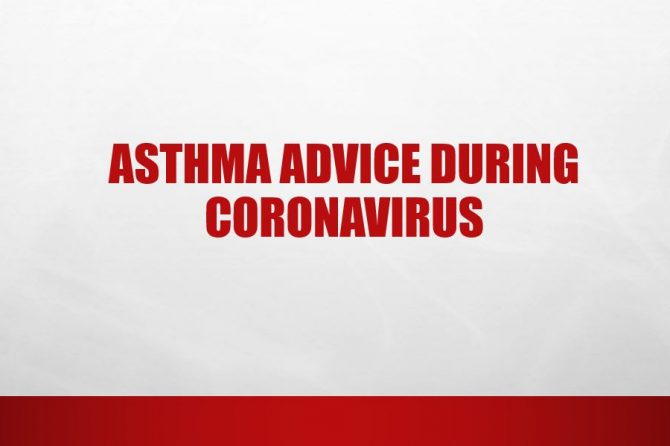
March 2020
At the moment it may be difficult for you to see a doctor about your asthma, but it is very important at this time to get your asthma as well controlled as possible. This means if you do catch a virus your lungs can deal with it better.
This information is to try to help improve asthma at a time when not everyone can see a doctor so this sheet may not apply to everyone but is useful guidance.
1) Take your inhalers as prescribed by your doctor. Often this is two puffs in the morning and two at night of your inhaler that doctors may call a ‘preventer’ inhaler. Sometimes we miss several doses, but it is important now not to forget to take them.
Your preventer inhaler is NOT blue but may be many colours including brown, white, purple, grey or pink. Your blue inhaler is what doctors often call a reliever inhaler.
If you have been prescribed a tablet for your asthma (for example, Montelukast) please take every day as prescribed.
2) If you feel your asthma could be better, for example you have symptoms more than twice a week, you can double the number of puffs of your preventer. For example, if you use Fostair two puffs twice a day you can increase to total of eight puffs a day – you can take four in the morning and four in the evening, or you can take extra ones during the day. This is just temporary and should be reviewed but if you cannot see a doctor keep this level for three months then try slowly reducing by one puff every week. You always want to keep your asthma as well controlled as possible using the minimum dose for you.
Your preventer contains either just an inhaled steroid (eg Clenil, Beclometasone, Qvar, Asmabec, Budesonide) or both an inhaled steroid and a longer acting bronchodilator – this is like a long acting version of the blue inhaler, (eg Symbicort, Fostair, Seretide, Flutiform, Sidrulpa, Relvar, DuoResp).
3) If you feel a slight cold coming on or any chest symptoms at all (cough, short of breath, chest tightness), then double your puffs or your preventer.
IF IT WORSENS DO NOT HESITATE TO PHONE YOUR DOCTOR OR NHS 111 OR GO TO A&E. You are at higher risk of having an asthma attack that requires hospital care or oral steroids if you have had an asthma attack in the past, even if it was several years ago.
4) Smoking should be stopped. Smoking will worsen your asthma and increase your risk of getting chest infections
5) Make sure you are taking your inhalers as well as possible. This is VERY important. Often, we have been taking them for years and people check how we take them and say it is fine. But right now, it is very important to check we are still taking them correctly.
If you are able to access a computer/phone a new website shows us how to take all inhalers. It is helpful to ask someone else to watch the video for your particular inhaler with you and then watch you taking it, if you can.
You may find the website RightBreathe useful and there is also an app which you can download on your phone.
6) You can use the blue inhaler too, but this should be done at the same time as using the preventer inhaler. The preventer reduces inflammation in the lungs and has long term preventative effect, but the blue inhaler only has an immediate effect.
7) Use a spacer if advised to. If you have a spacer or Aerochamber at home then use it. The RightBreathe website also shows how to use this. If you are finding it difficult to hold your breath then do the multibreath technique with your spacer, as is shown in the video and written down here:
Multiple breath method
1) Assemble spacer (if necessary)
2) Remove inhaler cap
3) Check dose counter (if device has one)
4) Hold inhaler upright and shake well
5) Insert inhaler upright into spacer
6) Put mouthpiece between teeth (without biting) and close lips to form good seal
7) Breathe out gently, into the spacer
8) Keep spacer horizontal and press down firmly on inhaler canister once
9) Breathe in and out normally for 3 or 4 breaths
10) Remove spacer from mouth
11) Breathe out gently
12) Remove inhaler from spacer
13) If more than one dose is needed, repeat all steps starting from step 4
14) Replace inhaler cap
Dr Chloe Bloom
Honorary Respiratory Consultant, Imperial College NHS Trust
